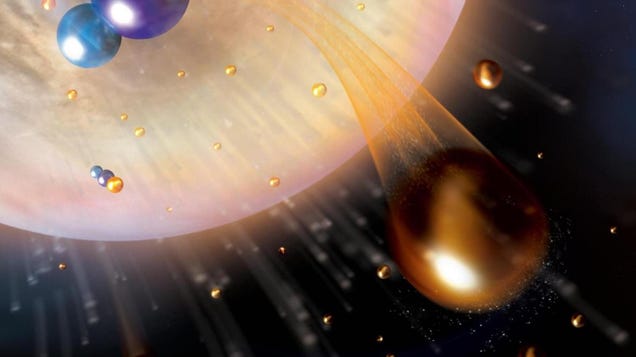Around 4.5 billion years ago, Earth and Venus were born in the midst of a chaotic star system. With the neighboring worlds being of the same size and similar structure, it’s believed that both planets likely began with similar amounts of water. Today, however, Venus is a hellish world with intense heat and crushing pressure, and most of its water is gone.
NASA Delays Return to Earth’s Evil Twin, Venus
Scientists aren’t sure how it became an intense desert-like planet, but new research suggests the culprit may be a particular type of molecule escaping to space and draining Venus of the last of its water.
A group of planetary scientists from the University of Colorado Boulder probed the chemical reactions that take place in Venus’ atmosphere using computer models and found that a molecule called HCO+ (an ion made up of one atom each of hydrogen, carbon, and oxygen) is likely responsible for Venus’ arid conditions. The findings were published this week in the journal Nature.
“The surface of Venus is about as hot as a pizza oven,” Eryn Cangi, a research scientist at the Laboratory for Atmospheric and Space Physics (LASP) and co-lead author of the new paper, told Gizmodo. “Venus and Mars are two possible ends of the spectrum of planetary habitability. We know that Earth is habitable, that Venus is too hot, and that Mars is too cold, but they both lost water.”
Early on in Venus’ history, the planet may have lost a lot of its water through atmospheric escape. The Sun is constantly spewing out solar wind—a stream of charged particles—throughout the solar system and past the planets. Earth is lucky to have a magnetic field that shields it from the solar wind, while Venus gets slammed by it. As a result, scientists think that Venus lost part of its water due to solar wind hitting its upper atmosphere, causing the water molecules to escape over the 4,500 million years since the planet’s birth.
This process can remove a lot of the water, but it doesn’t account for how much water Venus has lost until today. “If I dump out my water bottle, I get rid of most of the water, but there’s still some drops in there,” Cangi said. “We see such a low amount of water on Venus today, it doesn’t quite match.”
The process through which Venus lost the rest of its water, and continues to lose its last remaining bits of the precious liquid until today, has puzzled scientists for years. The new study suggests that Venus is losing water through a mechanism called dissociative recombination, whereby the positive ions of HCO+ are mixing with water and forming a positively charged molecule. Since opposites attract, the molecule will attract a negatively charged electron and they will combine.
Once they do, however, the resulting molecule has too much energy to stay together and so it breaks apart. The hydrogen will then escape from the planet’s atmosphere because it gained too much energy from the joining and breaking-apart process. “That’s just a basic chemistry reaction, so that could have been going on in early Venus but continues through today, removing the last of that water,” Cangi said.
It’s important to note that the study did not directly detect HCO+ in Venus’ atmosphere; previous missions to the neighboring planet have lacked the instruments designed to search for the molecule in the atmosphere. Data from previous missions, however, showed evidence for some of the molecules that react to form HCO+.
Upcoming missions to Venus, like VERITAS and DAVINCI, will also not be equipped with the proper instruments, so the scientists behind the new study are suggesting a new mission to Venus that will measure the molecules in its upper atmosphere.
“We like to say in science that all models are to some extent wrong, but some are useful,” Cangi said. “But a mission like that would really complement the upcoming Venus mission suite to help us complete the picture of water escape from Venus.”






